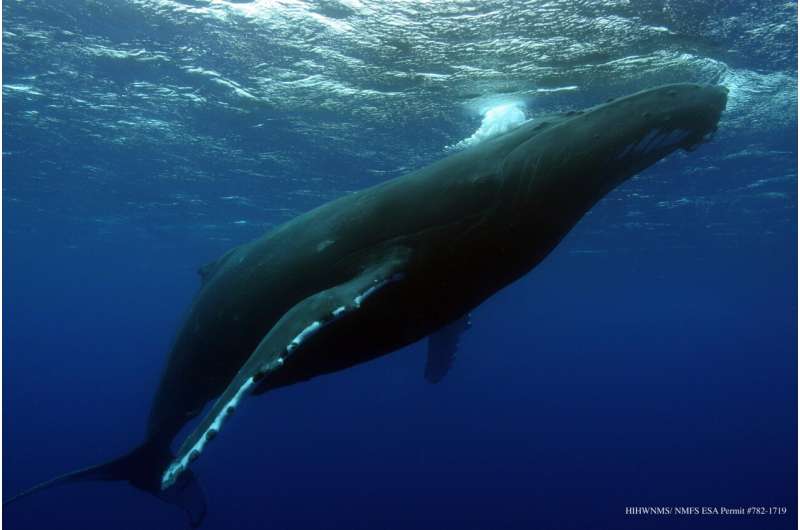Credit: HIHWNMS/NMFS ESA License #782-1719
Humpback whales may one day avoid Hawaiian waters due to climate change and rising greenhouse gases, according to the findings of a new paper published in Frontiers in Marine Science by a team of researchers, including three graduate students from the University of Hawai’i at Mānoa – Hannah von Hammerstein and Renee Setter of the Geography and Environment Department of the College of Social Sciences, and Martin van Aswegen of the Marine Mammal Research Program at the Institute of Marine Biology.
Humpback whales are known to migrate to tropical coastal waters, such as that of Hawaii, where they give birth to their calves. These areas are in regions with sea surface temperatures between 21 and 28 degrees Celsius (about 70-82 degrees Fahrenheit), and the whales typically return to the same locations every year.
According to von Hammerstein, Setter, van Aswegen and co-researchers at the Pacific Whale Foundation, anthropogenic climate change is warming the oceans at unprecedented rates. At the current rate, it is likely that some of these breeding grounds will warm above the temperature range of 21-28°C in the next century.
Using a statistical “delta downscaling” method to increase the resolution of global sea surface temperatures and track the critical isotherms of 21-28°C (lines drawn on a map or map connecting points of the same temperature) bordering humpback whale breeding grounds across the country 21st century research suggests two possible climate change scenarios:
In the worst-case scenario, with continued high development and unabated carbon emissions, by 2100, 67% of humpback whale breeding grounds will exceed the critical sea surface temperature of 28°C.
In a middle-of-the-road scenario with global and international institutions working on emissions reduction targets, that number would drop to 35% of breeding grounds.
Credit: NOAA
“We expected critical warming in some breeding areas, but the number of areas severely affected was a surprise,” von Hammerstein said. “While the results of the study are discouraging, they also highlight the differences between the two emissions scenarios and what can still be gained by implementing mitigation measures.”
Setter added: “It’s really critical that we try to reduce our greenhouse gas emissions and really try to at least stick with that ‘middle-of-the-road’ greenhouse gas emissions scenario so we can get as much of those breeding grounds as possible.” possibly from crossing that critical temperature threshold.”
The researchers note that while it’s not currently known whether humpback whales will continue to migrate to breeding grounds above 28°C, they hope their findings could provide an incentive for policymakers to work to reduce emissions, not just in Hawaii but. also on an international level.
“Our findings provide yet another example of what’s to come with anthropogenic climate change, with humpback whales representing only one affected species,” Van Aswegen said. “Improving our understanding of how ecosystems are going to change is critical for the effective and timely implementation of mitigation measures.”
Whales learn songs from each other in cultural deep dive
Quote: Humpback whales may be staying away from Hawaii due to climate change (July 2022, July 5) recovered July 5, 2022 from https://phys.org/news/2022-07-humpback-whales-hawaii-due-climate.html
This document is copyrighted. Other than fair dealing for personal study or research, nothing may be reproduced without written permission. The content is provided for informational purposes only.

